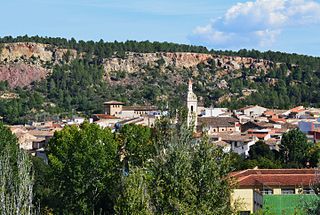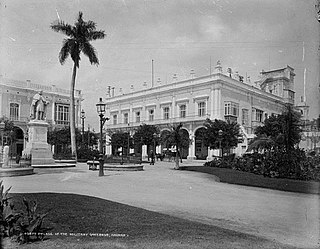Related Research Articles

Jerez de la Frontera or simply Jerez, also cited in old English-language sources as Xeres, is a city and municipality in the province of Cádiz in the autonomous community of Andalusia, Spain. Located in southwestern Iberia, it lies on the Campiña de Jerez, an inland low-land plain crossed by the Guadalete river, midway the Atlantic Ocean, the Guadalquivir river and the western reaches of the Subbaetic System.

Avilés is a town in Asturias, Spain. Avilés is, along with Oviedo and Gijón, one of the main cities in the Principality of Asturias.

Cienfuegos, capital of Cienfuegos Province, is a city on the southern coast of Cuba. It is located about 250 km (160 mi) from Havana and has a population of 178,368 in 2022. Since the late 1960s, Cienfuegos has become one of Cuba's main industrial centers, especially in the energy and sugar sectors. The city is dubbed La Perla del Sur. Despite being known as an industrial city of factories and various nuclear/electrical plants, and the name Cienfuegos literally translating to "one hundred fires", the city actually takes its name from the surname of Asturian-born José Cienfuegos Jovellanos, Captain General of Cuba (1816–19).

The Museum of the Revolution is located in the Old Havana section of Havana, Cuba, in what was the presidential palace of all Cuban presidents from Mario García Menocal to Fulgencio Batista. The building became the Museum of the Revolution during the years following the Cuban Revolution. The palace building was attacked by the Directorio Revolucionario 13 de Marzo in 1957.

Venezuela is a municipality and town in the Ciego de Ávila Province of Cuba. It is located immediately south of the provincial capital, Ciego de Ávila.

Anna is a municipality in Spain, located within Canal de Navarrés which is an administrative subdivision in the province of Valencia. That province is in the middle of the autonomous Valencian Community.

The Plaza Mayor in Trinidad, Cuba, is the historic centre of the town, declared a UNESCO World Heritage Site in 1988.

The National Museum of Fine Arts of Havana in Havana, Cuba is a museum of fine arts that exhibits Cuban art collections from the colonial times up to contemporary generations.

The historic center of Mexico City, also known as the Centro or Centro Histórico, is the central neighborhood in Mexico City, Mexico, focused on the Zócalo and extending in all directions for a number of blocks, with its farthest extent being west to the Alameda Central. The Zocalo is the largest plaza in Latin America. It can hold up to nearly 100,000 people.

The Palacio de los Capitanes Generales is the former official residence of the Spanish Empire's governors of Havana, Cuba, and in the Post-Colonial Period was for many time the City Hall. Located on the eastern side of the Plaza de Armas in Old Havana it is home to the Museum of the City of Havana. It houses exhibitions of art and historical artefacts and many of the rooms are preserved with their original Colonial decoration.

Palacio de los Deportes de León, also known as Palacio Municipal de los Deportes de León is a Multi-use Indoor arena in León, Spain. Built in 1970, it has a seating capacity of 5,188 seats, and is currently the home venue for Baloncesto León basketball team and CB Ademar León handball team.

Los Palacios y Villafranca is a city located in the province of Seville, Spain. According to the 2006 census (INE), the city has a population of 35,225 inhabitants.
Mario Bencomo is an artist. As an unaccompanied minor he was sent by his parents to live in Spain. At the age of 14, he left Madrid for the U.S., arriving by himself in New York City in the 1960s. He often returns to Europe, and for many years now for regular visits to Montreal, Canada. In 1996 he returns to visit Cuba for the first time, three decades after he left. An American Citizen, he is based in Miami.

Los Palacios is a municipality and town in the Pinar del Río Province of Cuba. It was founded in 1760.

The Palacio Municipal de Caracas, or Consejo Municipal de Caracas, is the city hall of Caracas, Venezuela. It is located on the corner of Gradillas a Monjas opposite the Plaza Bolívar, occupying half of the plaza's southern section. The building dates from the seventeenth century but now bears the mark of Alejandro Chataing's Neoclassical additions in 1906. It was the focal point for the Constitutional Convention, and signing of the Declaration of Independence in the nineteenth century. The present building is the result of the work undertaken by the Venezuelan architect Alejandro Chataing in 1906. The west wing of the building, the Capilla de Santa Rosa de Lima, the chapel where Venezuela's independence was declared in 1811, has been fully restored and furnished with authentic period pieces. The ground floor houses the Museo Caracas, which contains works by Venezuela's most celebrated painters and many other historic artifacts. It was declared a National Historic Landmark on 16 February 1979.
Alirio Palacios was a Venezuelan visual artist known for his drawings, graphic designing, printmaking and sculpture. Horse figures were often motifs of his graphic art and sculpture, an obsession he developed during his long stay in China. Among other awards, Palacios won the National Prize of Plastic Arts of Venezuela in 1977. His work is on display in museums and public sites internationally, including the presidential Palace and the National Supreme Court in Caracas, the Casa de Las Américas in Havana, and the University of Edinburgh where Palacio's portrait of the first Venezuelan President José María Vargas is on permanent display.

There is an abandoned Jai alai court in the back of the Hermanos Ameijeiras Hospital, the site of the old Casa de Beneficencia, on Calles Concordia and Lucenas near Calle Belascoain, an area that had been considered in the early part of the city as a place to locate the helpless and the unwanted, it was the edge of the city and the countryside known as the "basurero"; the spectator stands were parallel to Calle Concordia, the front wall of the court faced Calle Lucenas, east in the direction towards Old Havana. The original building has been annexed by five stories of residential concrete construction on the north side along Calle Virtudes. The Havana Jai alai fronton was known as "the palace of screams".

The Palacio del Segundo Cabo was built in the last decades of the 18th century, between 1770 and 1791, as part of the urban improvement project around the Plaza de Armas.